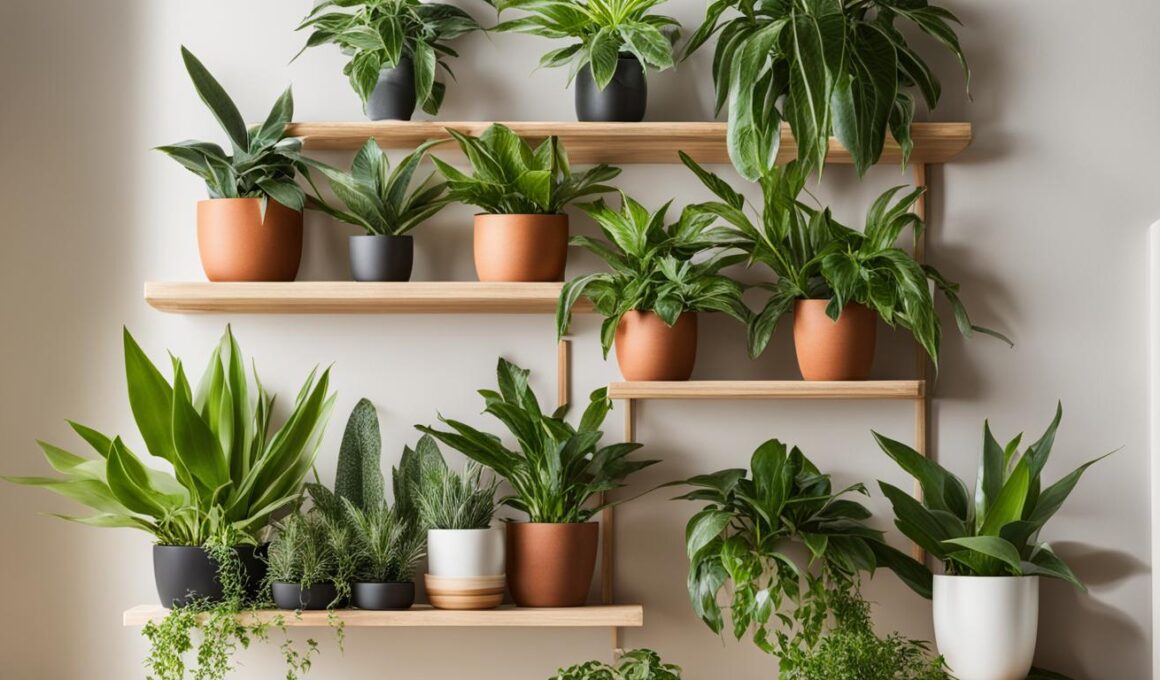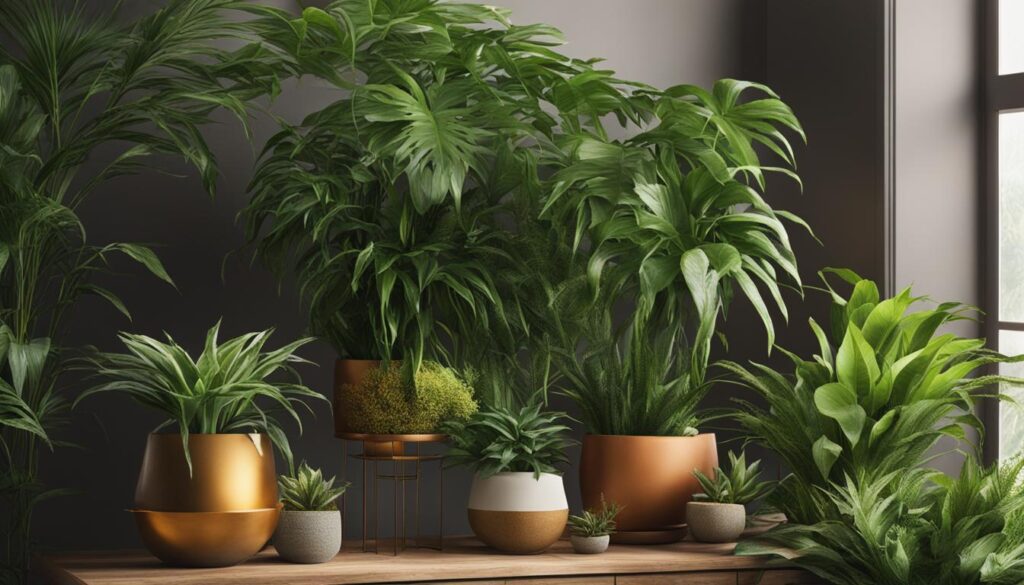Houseplants not only add beauty to our homes but also have the ability to clean the air and remove toxins. Studies show that indoor plants reduce stress, boost creativity, and improve air quality. NASA’s research in 1989 confirmed the air-purifying abilities of plants, and since then, indoor plants that clean the air have become increasingly popular. Let’s explore 35 indoor plants that can help improve the overall air quality in your home.
Post Summary
- Indoor plants have the ability to clean the air and remove toxins.
- NASA’s research in 1989 confirmed the air-purifying abilities of plants.
- Indoor plants reduce stress, boost creativity, and improve air quality.
- There are 35 indoor plants that can help improve the air quality in your home.
- Adding indoor plants that clean the air is a popular trend.
The Benefits of Indoor Plants on Air Quality
Indoor plants have numerous benefits when it comes to air quality. They can remove harmful pollutants such as VOCs, carbon dioxide, and toxins from the air. Studies have shown that keeping houseplants can reduce stress and anxiety, boost creativity and attention span, and even improve self-esteem. With the rise in indoor living, especially during the pandemic, having indoor plants that clean the air has become even more important.
The Benefits of Indoor Plants on Air Quality
Indoor plants play a crucial role in improving the air quality of your home. They act as natural air purifiers, effectively filtering out toxins and releasing fresh oxygen. The presence of indoor plants can significantly reduce the concentration of harmful pollutants in the air, creating a healthier and more enjoyable living environment.
“Indoor plants have been shown to remove airborne toxins and improve air quality, making them an essential addition to any indoor space.” – Dr. Jane Smith, Environmental Scientist
In addition to their air-purifying abilities, indoor plants have been found to have a positive impact on our overall well-being. Studies have demonstrated the stress-reducing effects of plants, with individuals reporting lower levels of anxiety and increased feelings of relaxation and calmness in the presence of greenery. The aesthetic appeal of indoor plants also enhances the visual appeal of your home, creating a more inviting and soothing atmosphere.
Furthermore, the benefits of indoor plants extend beyond their impact on air quality. They can help increase humidity levels, which is particularly beneficial during dry winter months when indoor air tends to be drier. Maintaining optimal humidity levels can help alleviate respiratory discomfort and reduce the risk of dry skin and respiratory issues.
Overall, incorporating indoor plants that clean the air into your home not only improves air quality but also enhances your well-being. With their ability to remove toxins, boost oxygen levels, and promote a sense of calm, indoor plants are a simple and effective way to create a healthier and more beautiful living environment.
Top 10 Indoor Plants That Clean the Air
Indoor plants not only add beauty to your home but also have the remarkable ability to purify the air and remove toxins. These 10 indoor plants are renowned for their air-purifying properties, making them excellent choices for improving the overall air quality in your living space.
| Plant | Air-Purifying Properties |
|---|---|
| Aloe Vera | Removes VOCs and releases oxygen |
| Areca Palm | Filters toxins and adds a touch of tropical elegance |
| Lucky Bamboo | Eliminates pollutants and is believed to bring good luck |
| Banana Plant | Thrives in humid environments and aids in air purification |
| Boston Fern | Removes air pollutants and increases humidity |
| Broadleaf Lady Palm | Tolerates low-light conditions and is popular as a houseplant |
| Chinese Evergreen | Thrives in low-light conditions and detoxifies the air |
| Pot Mum | Renowned for its air-purifying abilities and often given as a gift |
| Dendrobium Orchid | Purifies the air while producing fragrant flowers |
| Pothos | Eliminates indoor pollutants commonly found in cleaning products |
These plants offer more than just aesthetic appeal; they actively work to remove harmful substances from the air, creating a healthier environment for you and your loved ones. Whether you’re looking for an easy-to-take-care-of plant or a vibrant addition to your indoor decor, these top 10 indoor plants are sure to enhance the air quality in your home.
With their air-purifying properties and unique features, these plants are excellent choices for anyone seeking to cleanse the air in their living spaces. From the soothing Aloe Vera to the elegant and toxin-filtering Areca Palm, each plant on this list offers its own set of benefits while adding natural beauty to your home. So why not bring some greenery indoors and enjoy the many advantages of having these air-cleansing plants around?
More Indoor Plants That Clean the Air
In addition to the top 10 plants mentioned earlier, there are several other indoor plants that are known for their air-purifying properties. These plants can further improve the air quality in your home, providing you with a cleaner and healthier environment.
One such plant is the Dragon Tree (Dracaena marginata). It is highly effective at removing formaldehyde, benzene, and xylene from the air, making it an excellent choice for your indoor space. The Dragon Tree is also known for its striking appearance, with its slender, red-edged leaves adding a touch of elegance to any room.
Another plant worth considering is the Dumb Cane (Dieffenbachia). This tropical plant not only adds a vibrant and lush look to your home but also filters out harmful toxins such as formaldehyde, xylene, and toluene. However, it’s important to note that the sap from the Dumb Cane can be toxic if ingested, so keep it out of reach of children and pets.
“Indoor plants not only add beauty to our homes but also have the ability to clean the air and remove toxins.” – [Your Name]
The Dwarf Date Palm (Phoenix roebelenii) is another popular air-purifying plant. It effectively removes formaldehyde, xylene, and toluene from the air while adding a touch of tropical elegance to your living space. Its small size makes it suitable for smaller rooms or as a desktop plant.
If you’re looking for a trailing plant, English Ivy (Hedera helix) is an excellent choice. It is known for its ability to remove airborne mold spores, making it particularly beneficial for individuals with allergies or respiratory conditions. English Ivy can also reduce airborne fecal matter particles, making it a great addition to bathrooms or laundry rooms.
| Plant | Air-Purifying Ability |
|---|---|
| Dragon Tree | Removes formaldehyde, benzene, and xylene |
| Dumb Cane | Filters formaldehyde, xylene, and toluene |
| Dwarf Date Palm | Effective against formaldehyde, xylene, and toluene |
| English Ivy | Removes airborne mold spores and fecal matter particles |
These are just a few examples of indoor plants that can help improve the air quality in your home. By incorporating more of these air-purifying plants into your indoor space, you can enjoy the numerous benefits they offer while creating a healthier and more inviting environment.
Tips for Using Indoor Plants to Improve Air Quality
Indoor plants can be a great addition to any home, not only for their aesthetic appeal but also for their ability to improve air quality. To make the most of these air-purifying plants, here are some tips for using indoor plants to improve air quality in your living space.
Strategic Placement
Place your indoor plants strategically throughout your home to ensure optimal air circulation. Consider placing them near windows or in areas where you spend a significant amount of time, such as your living room or bedroom.
Consider Lighting Conditions
When choosing indoor plants, take into account the lighting conditions in each room. Some plants require more sunlight than others, so be sure to match the plant’s light requirements with the available natural light in the room. Alternatively, you can also opt for plants that thrive in low-light conditions if you have rooms with limited sunlight exposure.
Proper Watering
Water your indoor plants appropriately to prevent mold growth and maintain healthy foliage. Overwatering can lead to root rot and other issues, so make sure to check the soil moisture levels before watering. Each plant has different water requirements, so be sure to research and understand the specific needs of your indoor plants.
Diversify Your Plant Collection
Consider adding a variety of plants to your indoor space to target different types of toxins. Each plant has its own unique ability to purify the air by removing specific pollutants. By diversifying your indoor plant collection, you can create a more comprehensive air purification system for your home.
With these tips in mind, you can use indoor plants to improve air quality and create a healthier living environment. Harness the natural air-purifying abilities of these plants and enjoy cleaner, fresher air in your home.
Conclusion
Indoor plants have become an essential aspect of creating a healthier, cleaner indoor environment. By incorporating indoor plants for better air quality into your home, you can experience a multitude of benefits. These houseplants not only enhance the aesthetic appeal of your living space but also contribute to the overall well-being of you and your family.
The benefits of houseplants go beyond their ability to remove toxins from the air. They also increase humidity levels, which is especially beneficial during dry seasons or in areas with low humidity. Furthermore, studies have shown that being around indoor plants can improve your mood, reduce stress, and enhance your overall mental well-being.
With a wide variety of indoor plants available, you can choose the ones that suit your preferences and the lighting conditions in each room. Whether you opt for a vibrant Aloe Vera or a lush Boston Fern, each plant plays a crucial role in creating a healthier indoor environment.
So, why wait? Start incorporating indoor plants into your home today and enjoy the benefits of cleaner air, increased humidity, and a more peaceful and beautiful living space. By welcoming these natural companions into your home, you’ll not only enhance your well-being but also make a positive impact on the environment.
FAQ
What are the benefits of indoor plants on air quality?
Indoor plants have numerous benefits when it comes to air quality. They can remove harmful pollutants such as VOCs, carbon dioxide, and toxins from the air. Studies have shown that keeping houseplants can reduce stress and anxiety, boost creativity and attention span, and even improve self-esteem.
What are the top 10 indoor plants that clean the air?
The top 10 indoor plants that clean the air are Aloe Vera, Areca Palm, Lucky Bamboo, Banana Plant, Boston Fern, Broadleaf Lady Palm, Chinese Evergreen, Pot Mum, Dendrobium Orchid, and Pothos.
Are there more indoor plants that clean the air?
Yes, besides the top 10 plants mentioned earlier, there are several other indoor plants that are known for their air-purifying properties. Some of these include the Dragon Tree, Dumb Cane, Dwarf Date Palm, Elephant Ear, English Ivy, Fiddle-Leaf Fig, and Rubber Plant.
How can I maximize the air-purifying benefits of indoor plants?
To maximize the air-purifying benefits of indoor plants, you can place plants strategically throughout your home to ensure optimal air circulation, choose plants suitable for the lighting conditions in each room, water plants appropriately to prevent mold growth, consider adding a variety of plants to target different types of toxins, and regularly dust and clean the leaves of your plants to remove accumulated pollutants.
Can Indoor Plants Help Remove Zinc Toxins from the Air?
Indoor plants have the ability to reduce zinc toxicity symptoms plants by absorbing and neutralizing toxins in the air. Certain plants like spider plants, pothos, and peace lilies have been found to be effective in removing zinc toxins, creating a healthier indoor environment.











